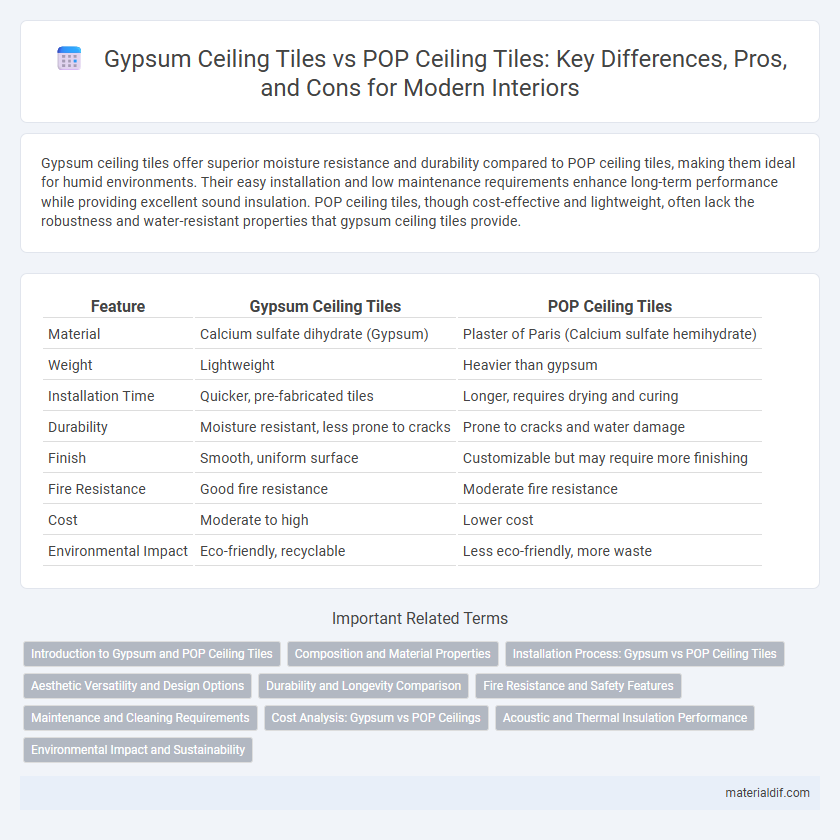Gypsum ceiling tiles offer superior moisture resistance and durability compared to POP ceiling tiles, making them ideal for humid environments. Their easy installation and low maintenance requirements enhance long-term performance while providing excellent sound insulation. POP ceiling tiles, though cost-effective and lightweight, often lack the robustness and water-resistant properties that gypsum ceiling tiles provide.
Table of Comparison
| Feature | Gypsum Ceiling Tiles | POP Ceiling Tiles |
|---|---|---|
| Material | Calcium sulfate dihydrate (Gypsum) | Plaster of Paris (Calcium sulfate hemihydrate) |
| Weight | Lightweight | Heavier than gypsum |
| Installation Time | Quicker, pre-fabricated tiles | Longer, requires drying and curing |
| Durability | Moisture resistant, less prone to cracks | Prone to cracks and water damage |
| Finish | Smooth, uniform surface | Customizable but may require more finishing |
| Fire Resistance | Good fire resistance | Moderate fire resistance |
| Cost | Moderate to high | Lower cost |
| Environmental Impact | Eco-friendly, recyclable | Less eco-friendly, more waste |
Introduction to Gypsum and POP Ceiling Tiles
Gypsum ceiling tiles are composed of natural mineral gypsum, known for their fire resistance, sound absorption, and moisture control properties, making them ideal for commercial and residential interiors. POP (Plaster of Paris) ceiling tiles, derived from heated gypsum powder, offer smooth, versatile designs with easy moldability but are less moisture-resistant compared to traditional gypsum tiles. Both materials provide aesthetic ceiling solutions, with gypsum excelling in durability and POP favored for intricate decorative finishes.
Composition and Material Properties
Gypsum ceiling tiles are primarily composed of natural gypsum, a mineral known for its fire-resistant and moisture-regulating properties, making them ideal for damp environments. POP (Plaster of Paris) ceiling tiles consist of finely ground gypsum that is calcined to create a quick-setting material, valued for its smooth finish and ease of molding into intricate designs. The inherent density of gypsum tiles offers superior sound insulation and durability, while POP tiles provide flexibility and rapid installation but may require additional treatment for moisture resistance.
Installation Process: Gypsum vs POP Ceiling Tiles
Gypsum ceiling tiles feature a straightforward installation process involving pre-cut panels that can be quickly fixed onto metal frameworks using screws or adhesive, reducing labor time and waste. POP (Plaster of Paris) ceiling tiles require a more intricate installation, starting with the application of a wet plaster mix on a framework, followed by careful shaping and drying, which demands skilled labor and extends project timelines. Gypsum tiles offer faster, cleaner installation with less mess, while POP tiles allow for more customized designs but involve a lengthier and more labor-intensive setup.
Aesthetic Versatility and Design Options
Gypsum ceiling tiles offer superior aesthetic versatility with a wide range of textures, finishes, and patterns that can easily complement modern and traditional interiors, enhancing visual appeal. Their lightweight and modular nature allows for quick installation and customization, enabling intricate designs and ease of maintenance compared to POP ceiling tiles. POP ceiling tiles, while popular for smooth finishes and simpler designs, lack the diverse decorative possibilities and durability found in gypsum options.
Durability and Longevity Comparison
Gypsum ceiling tiles exhibit superior durability due to their moisture resistance and fire-retardant properties, making them ideal for humid or high-heat environments. POP (Plaster of Paris) ceiling tiles, while aesthetically versatile, tend to be more brittle and susceptible to cracking over time, especially in areas with frequent temperature fluctuations or moisture exposure. The longevity of gypsum ceiling tiles typically surpasses POP tiles, offering extended maintenance intervals and enhanced structural stability in interior applications.
Fire Resistance and Safety Features
Gypsum ceiling tiles offer superior fire resistance compared to POP ceiling tiles due to their high calcium sulfate content, which acts as a natural fire retardant and prevents rapid flame spread. Gypsum tiles maintain structural integrity longer under high temperatures, reducing the risk of ceiling collapse during fires. POP ceiling tiles, primarily composed of plaster of Paris, are more prone to damage from heat, offering less effective fire safety performance.
Maintenance and Cleaning Requirements
Gypsum ceiling tiles require minimal maintenance due to their moisture-resistant properties and smooth surface that resists dust accumulation, making cleaning quick and effective with a soft cloth or mild detergent. POP (Plaster of Paris) ceiling tiles demand more frequent upkeep as they are prone to cracking and moisture damage, requiring careful handling during cleaning to avoid surface erosion. Regular inspection and gentle cleaning methods are essential for POP tiles to maintain their aesthetic appeal and structural integrity over time.
Cost Analysis: Gypsum vs POP Ceilings
Gypsum ceiling tiles generally cost more upfront compared to POP (Plaster of Paris) ceilings due to their durability and fire-resistant properties, making them a long-term investment. POP ceilings tend to be cheaper initially but require more frequent maintenance and repairs, increasing overall expenses over time. Cost analysis shows gypsum offers better value in durability and low maintenance despite a higher initial price point.
Acoustic and Thermal Insulation Performance
Gypsum ceiling tiles offer superior acoustic insulation by effectively absorbing sound and reducing echo, making them ideal for noise-sensitive environments, whereas POP (Plaster of Paris) ceiling tiles have limited sound absorption properties. In terms of thermal insulation, gypsum tiles provide better heat resistance due to their dense composition, helping maintain indoor temperature stability and reducing energy consumption. POP ceiling tiles, while aesthetically versatile, generally lack significant thermal insulation capabilities compared to gypsum options.
Environmental Impact and Sustainability
Gypsum ceiling tiles have a lower environmental impact due to their natural composition and recyclability, reducing waste in landfills compared to POP ceiling tiles, which often contain synthetic additives and generate more industrial waste. The production of gypsum tiles consumes less energy and emits fewer greenhouse gases, supporting sustainable building practices and green certifications like LEED. Furthermore, gypsum's ability to be recycled and its non-toxic properties make gypsum ceiling tiles a more eco-friendly choice over POP ceiling tiles in sustainable construction projects.
Gypsum ceiling tiles vs POP ceiling tiles Infographic

 materialdif.com
materialdif.com